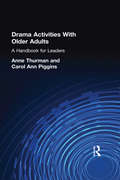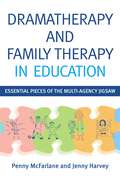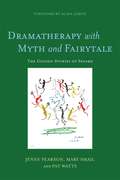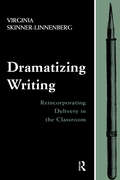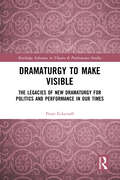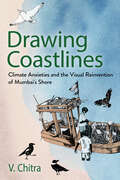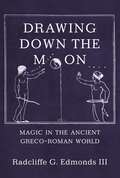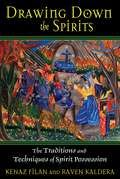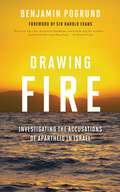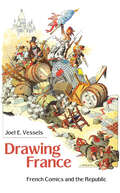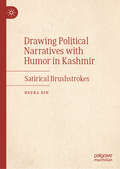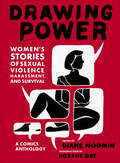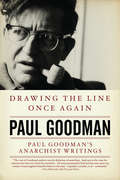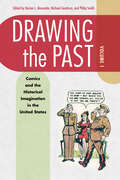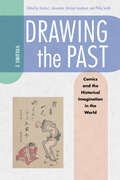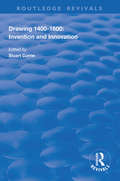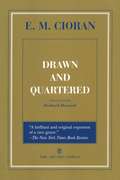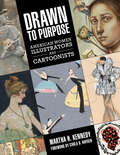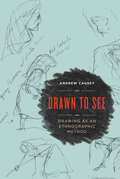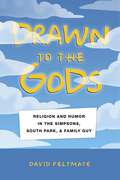- Table View
- List View
Drama Activities With Older Adults: A Handbook for Leaders
by Anne Thurman Carol Ann PigginsLead older adults in creative drama activities. This practical handbook provides step-by-step instructions for conducting over 50 introductory activities to stimulate the senses, awaken the imagination, activate body movement, encourage interaction, and stimulate verbal communication with the elderly. Written primarily for activity, recreation, and program directors of community/day care centers and in retirement homes who have some interest in drama but no formal training, Drama Activities With Older Adults features a wide array of group work skills. A number of complete model session plans are included which feature objectives, lists of materials needed, procedures for setting up the dramatic situation, and methods for evaluation.
Dramas, Fields, and Metaphors: Symbolic Action in Human Society (Symbol, Myth and Ritual)
by Victor TurnerIn this book, Victor Turner is concerned with various kinds of social actions and how they relate to, and come to acquire meaning through, metaphors and paradigms in their actors' minds; how in certain circumstances new forms, new metaphors, new paradigms are generated. To describe and clarify these processes, he ranges widely in history and geography: from ancient society through the medieval period to modern revolutions, and over India, Africa, Europe, China, and Meso-America.Two chapters, which illustrate religious paradigms and political action, explore in detail the confrontation between Henry II and Thomas Becket and between Hidalgo, the Mexican liberator, and his former friends. Other essays deal with long-term religious processes, such as the Christian pilgrimage in Europe and the emergence of anti-caste movements in India. Finally, he directs his attention to other social phenomena such as transitional and marginal groups, hippies, and dissident religious sects, showing that in the very process of dying they give rise to new forms of social structure or revitalized versions of the old order.
Dramatherapy and Family Therapy in Education
by Penny Mcfarlane Jenny HarveyA collaborative therapeutic approach often proves the best way to assess and meet the needs of children experiencing barriers to learning. This book gives a concise overview of drama and family therapy and describes how both therapies can work together to provide essential pieces of the jigsaw of emotional support for troubled children within an educational setting. Drawing on their own extensive experience, the authors give explanations of the models and techniques of their own specialist therapy, before exploring their joint work and innovative inclusion in a cooperative team of multi-disciplinary professionals. The book discusses the principles and protocols of a Multi Agency Support Team and looks at how the pieces come together in practice. Case studies are provided to illustrate the successful outcomes of this way of working, as well as the challenges it can present. This book will be vital reading for all professionals working alongside children, families and schools, who are interested in addressing the needs of the child on a deeper and more sustainable level.
Dramatherapy with Myth and Fairytale
by Jenny Pearson Mary Smail Pat WattsMyths and fairytales are our rich heritage; a veritable feast of ancient wisdom passed down through the ages in the memorable form of stories. While almost any story will have deep meaning to some individuals, some of the time, this book presents a collection of stories that these maestros of dramatherapy have found to have a powerful effect almost without fail. These are the 'golden' stories of Sesame. The authors introduce the Sesame approach and describe the advantages of using myth and fairy tale as a central theme in a therapy session. The Sesame approach has been found to produce striking results with myriad client groups, including individuals with learning difficulties, offenders in psychiatric settings and children with emotional and behavioural difficulties and adults in mental health care. Dramatherapy with Myth and Fairytale provides a treasure trove of timeless stories that can be adapted and applied to the needs of different client groups and the style of each therapist. It also includes introductory exercises, warm-ups and scene setting suggestions. The book will be an invaluable source of inspiration for dramatherapists and dramatherapy students, creative arts therapists, storytellers, psychotherapists, Jungian psychoanalysts, teachers and play therapists.
Dramatizing Writing: Reincorporating Delivery in the Classroom
by Virginia Skinner-LinnenbergAlthough speech departments have "owned" delivery for the last 100 years, those who teach writing, especially English departments, can gain a great deal by reinstating delivery into their conceptions of and theories about writing. Thus, in the author's vision of "dramatizing writing" in the composition classroom, delivery can have an impact on all the composing steps, from invention to final draft. The goals of this text are to redefine delivery for writing, to reunite it with other parts of the classical rhetorical canon, and to practically apply it in contemporary writing instruction. This text is divided into three main sections. The first provides a survey of the history of delivery in rhetorical theory. A continuum is set up from a totally physical conception of delivery to a noetic one which incorporates more intellectual processes. The argument is that the tension heightened by discord over its definition eventually led to the splitting of delivery from the rhetorical canon. A separate discussion of the women's challenge to delivery is also included. The next section contains a survey of facets of delivery that exist in current theory combined with the author's own theory of delivery. It provides insight into the state of delivery in contemporary writing instruction. The author argues that since the split of delivery from the rhetorical canon has caused a modern bias against delivery in writing theory, many strategies that could aid in the teaching of writing have either been overlooked or undertheorized. Therefore, she borrows from current theoretical areas within and outside of writing in order to construct her own theory of delivery. The last section provides practical applications of delivery in writing instruction. Again borrowing from many sources inside and outside of composition, she describes the techniques teachers may use to incorporate delivery in a writing classroom. Through the use of delivery, more strategies may be developed to aid in the teaching of writing. Special features include: * the incorporation of some practices that had been in use in the composition classroom for many years but did not have any consciously theoretical grounding; * the discussion of women rhetoricians' theories on delivery; * the combination of many contemporary theoretical areas including theatrical, feminist, rhetorical, and pedagogical to form the author's redefined theory of delivery; and * the presentation of practical applications of this new theory of delivery for teachers to utilize in their own classrooms.
Dramaturgy to Make Visible: The Legacies of New Dramaturgy for Politics and Performance in Our Times (ISSN)
by Peter EckersallThis book argues that dramaturgy makes things visible and does so in two distinct and interrelating ways: creative processes and formal elements of performance are rendered visible and readable; and performance dramaturgy becomes an expanded practice in which performance is a locus for creating wide-ranging events and activities.This exploration defines dramaturgy as a perceptibly transforming agency in the construction, presentation and reception of contemporary performance; and it shows how contemporary performance has an intrinsic dramaturgical aspect whose proliferation of dramaturgical practices has led to a far-reaching reinvention of what contemporary theatre is. In doing so, this book deals with a careful selection of performance practices, including theatrical adaptations, new media dramaturgy, contemporary dance, installation-performance, postdramatic theatre, visionary works by auteurs, and revivals of well-known stage shows.This study will be of great interest to students and scholars in theater studies, performance studies, cultural studies, curating, and dance scholarship.
Drawing Coastlines: Climate Anxieties and the Visual Reinvention of Mumbai's Shore (Expertise: Cultures and Technologies of Knowledge)
by V. ChitraDrawing Coastlines reveals the ways that technical images such as weather infographics, sea-level projections, and surveys are fast remaking Mumbai's coasts and coastal futures. They set in place infrastructural interventions, vocabularies of development and conservation, and their lines and dots inscribe material conditions of existence and horizons of loss that entangle life forms. V. Chitra interlaces graphics and text by redrawing scientific images, the moments of their construction, the choices and consequences of what gets drawn and what does not, and how images are seen, performed, and manifest. These visual reconstructions show how images remake human-nonhuman relationships, arrange urban politics, and materialize landscapes in complex and contradictory ways. The multimodal format of Drawing Coastlines engages in the politics of its context where words and images combine to create coastal worlds, and to find, through a creative anthropology, openings to build new forms of care in the midst of crisis.
Drawing Deportation: Art and Resistance among Immigrant Children
by Silvia Rodriguez VegaIllustrates how the children of immigrants use art to grapple with issues of citizenship, state violence, and belonging Young immigrant children often do not have the words to express how their lives are shaped by issues of immigration, legal status, and state-sanctioned violence. Yet they are able to communicate its effects on them using art. Based on ten years of work with immigrant children as young as six years old in Arizona and California— and featuring an analysis of three hundred drawings, theater performances, and family interviews—Silvia Rodriguez Vega provides accounts of children’s challenges with deportation and family separation during the Obama and Trump administrations. While much of the literature on immigrant children depicts them as passive, when viewed through this lens they appear as agents of their own stories. The volume provides key insights into how immigrant children in both states presented creative, out-of-the-box, powerful solutions to the dilemmas that anti-immigrant rhetoric and harsh immigration laws present. Through art, they demonstrated a righteous indignation against societal violence, dehumanization, and death as a tool for navigating a racist, anti-immigrant society. When children are the agents of their own stories, they can reimagine destructive situations in ways that adults sometimes cannot, offering us alternatives and hope for a better future. At once devastating and revelatory, Drawing Deportation provides a roadmap for how art can provide a safe and necessary space for vulnerable populations to assert their humanity in a world that would rather divest them of it.
Drawing Down the Moon: Magic in the Ancient Greco-Roman World
by III Radcliffe G. Edmonds IIIAn unparalleled exploration of magic in the Greco-Roman worldWhat did magic mean to the people of ancient Greece and Rome? How did Greeks and Romans not only imagine what magic could do, but also use it to try to influence the world around them? In Drawing Down the Moon, Radcliffe Edmonds, one of the foremost experts on magic, religion, and the occult in the ancient world, provides the most comprehensive account of the varieties of phenomena labeled as magic in classical antiquity. Exploring why certain practices, images, and ideas were labeled as “magic” and set apart from “normal” kinds of practices, Edmonds gives insight into the shifting ideas of religion and the divine in the ancient past and in the later Western tradition.Using fresh approaches to the history of religions and the social contexts in which magic was exercised, Edmonds delves into the archaeological record and classical literary traditions to examine images of witches, ghosts, and demons as well as the fantastic powers of metamorphosis, erotic attraction, and reversals of nature, such as the famous trick of drawing down the moon. From prayer and divination to astrology and alchemy, Edmonds journeys through all manner of ancient magical rituals and paraphernalia—ancient tablets, spell books, bindings and curses, love charms and healing potions, and amulets and talismans. He considers the ways in which the Greco-Roman discourse of magic was formed amid the cultures of the ancient Mediterranean, including Egypt and the Near East.An investigation of the mystical and marvelous, Drawing Down the Moon offers an unparalleled record of the origins, nature, and functions of ancient magic.
Drawing Down the Spirits: The Traditions and Techniques of Spirit Possession
by Raven Kaldera Kenaz FilanAn insider’s view of the inner workings and prevalence of spirit possession in our modern world • Provides practical techniques for preparation, safety, aftercare, and aborting harmful possessions • Reveals the forms of ritual possession present throughout the world--including Uganda, Nepal, Korea, Bali, Greece, Turkey, Scandinavia, and France Drawing Down the Spirits presents an insider’s view of the inner workings, sacred traditions, and prevalence of spirit possession existing in our modern world. Spirit possession is an integral part of shamanism as well as many neo-pagan forms of worship that draw down deities or invite spirit possession. However, spirit possession is not for the unprepared. In Drawing Down the Spirits, Kenaz Filan and Raven Kaldera, both initiated and experienced in shamanic and Vodou traditions, present the practical guidance needed to participate in ritual possession. Addressing the benefits and the dangers that await the naive, Filan and Kaldera show that there is no such thing as a guaranteed “safe” possession because spirits have their own agenda--and they are much more powerful than we are. The authors provide a variety of techniques to prepare for possession and abort possession and to promote the safety of the possessed as well as the spirits and witnesses present. With a wide-ranging look at the historic forms of ritual possession found throughout the world--including Uganda, Nepal, Korea, Bali, Greece, Turkey, Scandinavia, and France--the authors also include numerous firsthand accounts collected from witnesses of modern spirit possession.
Drawing Fire: Investigating the Accusations of Apartheid in Israel
by Benjamin PogrundBenjamin Pogrund, who spent 26 years as a journalist in South Africa investigating apartheid and who has been living in Israel for the past 15 years, investigates the accusation that Israel is practicing apartheid and the motives of those who make it. His study is founded on a belief in Israel, combined with frank criticism, to provide a balanced view of Israel’s strengths and problems. To understand Israel today, one must first look at the past and so the book first outlines key foundational events to explain current attitudes. It then explores the contradictions found in the region, including discrimination against Israeli Arabs and among Jews, before concluding that it is wrong to affix the apartheid label to Israel inside the Green Line of 1948/1967. It also deconstructs the criticisms of Israel and the boycott movement before arguing for two states, Israeli and Palestinian, as the only way forward for Jews and Arabs. This detailed and balanced study offers a unique comparison between South Africa a
Drawing France: French Comics and the Republic
by Joel E. VesselsIn France, Belgium, and other Francophone countries, comic strips—called bande dessinee or “BD” in French—have long been considered a major art form capable of addressing a host of contemporary issues. Among French-speaking intelligentsia, graphic narratives were deemed worthy of canonization and critical study decades before the academy and the press in the United States embraced comics. The place that BD holds today, however, belies the contentious political route the art form has traveled. In Drawing France: French Comics and the Republic, author Joel E. Vessels examines the trek of BD from it being considered a fomenter of rebellion, to a medium suitable only for semi-literates, to an impediment to education, and most recently to an art capable of addressing social concerns in mainstream culture. In the mid-1800s, alarmists feared political caricatures might incite the ire of an illiterate working class. To counter this notion, proponents yoked the art to a particular articulation of “Frenchness” based on literacy and reason. With the post-World War II economic upswing, French consumers saw BD as a way to navigate the changes brought by modernization. After bande dessinee came to be understood as a compass for the masses, the government, especially Francois Mitterand’s administration, brought comics increasingly into “official” culture. Vessels argues that BD are central to the formation of France’s self-image and a self-awareness of what it means to be French.
Drawing Out Law
by John BorrowsThe Anishinabek Nation's legal traditions are deeply embedded in many aspects of customary life. In Drawing Out Law, John Borrows (Kegedonce) skillfully juxtaposes Canadian legal policy and practice with the more broadly defined Anishinabek perception of law as it applies to community life, nature, and individuals.This innovative work combines fictional and non-fictional elements in a series of connected short stories that symbolize different ways of Anishinabek engagement with the world. Drawing on oral traditions, pictographic scrolls, dreams, common law case analysis, and philosophical reflection, Borrows' narrative explores issues of pressing importance to the future of indigenous law and offers readers new ways to think about the direction of Canadian law.Shedding light on Canadian law and policy as they relate to Indigenous peoples, Drawing Out Law illustrates past and present moral agency of Indigenous peoples and their approaches to the law and calls for the renewal of ancient Ojibway teaching in contemporary circumstances.This is a major work by one of Canada's leading legal scholars, and an essential companion to Canada's Indigenous Constitution.
Drawing Political Narratives with Humor in Kashmir: Satirical Brushstrokes
by Heeba DinThis book explores the remarkable ability of political cartoons in the region to craft and preserve an alternative narrative by employing the potent tool of political humor. Over the centuries, political humor, delivered through satire, caricature, ridicule, or irony, has been a powerful instrument for scrutinizing the establishment and unveiling the shortcomings and absurdities within society. In this book, the author delves into the meaning-generational structures utilized by political cartoons to amplify the underlying political-socio-cultural ideologies. It also investigates the pivotal role of political humor in shaping and defining the discourse in Kashmir. This book sheds light on the enduring impact of satire and caricature as instruments for not only commenting on contemporary issues but also for creating and sustaining a collective memory that reflects the complex sociopolitical dynamics that have characterized Kashmir throughout its history.
Drawing Power: Women's Stories of Sexual Violence, Harassment, and Survival
by Diane Noomin; Roxane GayInspired by the global #MeToo Movement, Drawing Power: Women’s Stories of Sexual Violence, Harassment, and Survival is a collection of original, nonfiction comics drawn by more than 60 female cartoonists from around the world. Featuring such noted creators as Emil Ferris, Aline Kominsky-Crumb, MariNaomi, Liana Finck, and Ebony Flowers the anthology’s contributors comprise a diverse group of many ages, sexual orientations, and races—and their personal stories convey the wide spectrum of sexual harassment and abuse that is still all too commonplace. With a percentage of profits going to RAINN, Drawing Power is an anthology that stokes the fires of progressive social upheaval, in the fight for a better, safer world. Full list of contributors: Rachel Ang, Zoe Belsinger, Jennifer Camper, Caitlin Cass, Tyler Cohen, Marguerite Dabaie, Soumya Dhulekar, Wallis Eates, Trinidad Escobar, Kat Fajardo, Joyce Farmer, Emil Ferris, Liana Finck, Sarah Firth, Mary Fleener, Ebony Flowers, Claire Folkman, Noel Franklin Katie Fricas, Siobhán Gallagher, Joamette Gil, J. Gonzalez-Blitz, Georgiana Goodwin, Roberta Gregory, Marian Henley, Soizick Jaffre Avy Jetter, Sabba Khan, Kendra Josie Kirkpatrick, Aline Kominsky-Crumb, Nina Laden, Miss Lasko-Gross, Carol Lay, Miriam Libicki Sarah Lightman, LubaDalu, Ajuan Mance, MariNaomi, Lee Marrs, Liz Mayorga, Lena Merhej, Bridget Meyne, Carta Monir, Hila Noam Diane Noomin, Breena Nuñez, Meg O’Shea, Corinne Pearlman, Cathrin Peterslund, Minnie Phan, Kelly Phillips, Powerpaola, Sarah Allen Reed, Kaylee Rowena, Ariel Schrag, M. Louise Stanley, Maria Stoian, Nicola Streeten, Marcela Trujillo, Carol Tyler, Una, Lenora Yerkes, Ilana Zeffren
Drawing from Life: Memory and Subjectivity in Comic Art
by Jane TolmieAutobiography has seen enormous expansions and challenges over the past decades. One of these expansions has been in comics, and it is an expansion that pushes back against any postmodern notion of the death of the author/subject, while also demanding new approaches from critics. Drawing from Life: Memory and Subjectivity in Comic Art is a collection of essays about autobiography, semi-autobiography, fictionalized autobiography, memory, and self-narration in sequential art, or comics. Contributors come from a range of academic backgrounds including English, American studies, comparative literature, gender studies, art history, and cultural studies. The book engages with well-known figures such as Art Spiegelman, Marjane Satrapi, and Alison Bechdel; with cult-status figures such as Martin Vaughn-James; and with lesser-known works by artists such as Frédéric Boilet. Negotiations between artist/writer/body and drawn/written/text raise questions of how comics construct identity, and are read and perceived, requiring a critical turn towards theorizing the comics' viewer. At stake in comic memoir and semi-autobiography is embodiment. Remembering a scene with the intent of rendering it in sequential art requires nonlinear thinking and engagement with physicality. Who was in the room and where? What was worn? Who spoke first? What images dominated the encounter? Did anybody smile? Man or mouse? Unhinged from the summary paragraph, the comics artist must confront the fact of the flesh, or the corporeal world, and they do so with fascinating results.
Drawing the Line Once Again: Paul Goodman's Anarchist Writings
by Paul GoodmanPainting a vivid picture of 1960s counterculture ideas, this new collection of the late Paul Goodman's essential anarchist writings—from utopian essays to practical proposals—reveals how he inspired the dissident youth of the era and profoundly influenced movement theory and practice. Long out-of-print, these provocative, insightful, and incisive pieces analyze citizenship and civil disobedience, decentralization and the organized system—all while still mindful of the long anarchist tradition and of the Jeffersonian democracy that resonated strongly in Goodman's own political thought. A potent antidote to U.S. global imperialism and domestic anomie, this collection also includes a new introduction by Goodman's friend and literary executor, Taylor Stoehr, who explains why these nine core texts will thoroughly explicate anarchism for future generations.
Drawing the Past, Volume 1: Comics and the Historical Imagination in the United States
by Dorian L. Alexander, Michael Goodrum and Philip SmithContributions by Lawrence Abrams, Dorian L. Alexander, Max Bledstein, Peter Cullen Bryan, Stephen Connor, Matthew J. Costello, Martin Flanagan, Michael Fuchs, Michael Goodrum, Bridget Keown, Kaleb Knoblach, Christina M. Knopf, Martin Lund, Jordan Newton, Stefan Rabitsch, Maryanne Rhett, and Philip SmithHistory has always been a matter of arranging evidence into a narrative, but the public debate over the meanings we attach to a given history can seem particularly acute in our current age. Like all artistic mediums, comics possess the power to mold history into shapes that serve its prospective audience and creator both. It makes sense, then, that history, no stranger to the creation of hagiographies, particularly in the service of nationalism and other political ideologies, is so easily summoned to the panelled page. Comics, like statues, museums, and other vehicles for historical narrative, make both monsters and heroes of men while fueling combative beliefs in personal versions of United States history.Drawing the Past, Volume 1: Comics and the Historical Imagination in the United States, the first book in a two-volume series, provides a map of current approaches to comics and their engagement with historical representation. The first section of the book on history and form explores the existence, shape, and influence of comics as a medium. The second section concerns the question of trauma, understood both as individual traumas that can shape the relationship between the narrator and object, and historical traumas that invite a reassessment of existing social, economic, and cultural assumptions. The final section on mythic histories delves into ways in which comics add to the mythology of the US.Together, both volumes bring together a range of different approaches to diverse material and feature remarkable scholars from all over the world.
Drawing the Past, Volume 2: Comics and the Historical Imagination in the World
by Dorian L. Alexander, Michael Goodrum and Philip SmithContributions by Dorian L. Alexander, Chris Bishop, David Budgen, Lewis Call, Lillian Céspedes González, Dominic Davies, Sean Eedy, Adam Fotos, Michael Goodrum, Simon Gough, David Hitchcock, Robert Hutton, Iain A. MacInnes, Małgorzata Olsza, Philip Smith, Edward Still, and Jing Zhang In Drawing the Past, Volume 2: Comics and the Historical Imagination in the World, contributors seek to examine the many ways in which history worldwide has been explored and (re)represented through comics and how history is a complex construction of imagination, reality, and manipulation. Through a close analysis of such works as V for Vendetta, Maus, and Persepolis, this volume contends that comics are a form of mediation between sources (both primary and secondary) and the reader. Historical comics are not drawn from memory but offer a nonliteral interpretation of an object (re)constructed in the creator’s mind. Indeed, when it comes to history, stretching the limits of the imagination only serves to aid in our understanding of the past and, through that understanding, shape ourselves and our futures. This volume, the second in a two-volume series, is divided into three sections: History and Form, Historical Trauma, and Mythic Histories. The first section considers the relationship between history and the comic book form. The second section engages academic scholarship on comics that has recurring interest in the representation of war and trauma. The final section looks at mythic histories that consciously play with events that did not occur but nonetheless inflect our understanding of history. Contributors to the volume also explore questions of diversity and relationality, addressing differences between nations and the cultural, historical, and economic threads that bind them together, however loosely, and however much those bonds might chafe.Together, both volumes bring together a range of different approaches to diverse material and feature remarkable scholars from all over the world.
Drawing, 1400-1600: Invention and Innovation (Routledge Revivals)
by Stuart CurrieFirst published in 1998, this volume twelve scholars explore ways in which drawings were employed and appreciated in various European Cities form late medieval times, through the Renaissance and Reformation periods and into the early seventeenth century. The essayists examine the relationship between preparatory sketches and finished artworks in more durable and expensive materials, and consider the roles played by various drawing types, such as studies from different kinds of model and student copies from a master’s exemplar. They also investigate how drawings and their mechanically- reproduced equivalents- engravings, etchings and other forms of print – came to be collected for both practical and connoisseurial purposes, and how iconographical and stylistic inventiveness were linked to imaginative artistic interpretations of traditional subjects and to technical innovations in drawing and printmaking. Through diverse approaches to the study of artists’ attitudes and ambitions, the essays in Drawing 1400-1600 offer ways of appreciating the complex and fascinating history of the practice and theory of drawing over two centuries during which the expressive potential of the medium was realized in some of the greatest artistic statements of all time.
Drawn and Quartered
by E. M. Cioran Eugene ThackerIn this collection of aphorisms and short essays, E.M. Cioran sets about the task of peeling off the layers of false realities with which society masks the truth. For him, real hope lies in this task, and thus, while he perceives the world darkly, he refuses to give in to despair. He hits upon this ultimate truth by developing his notion of human history and events as "a procession of delusions," striking out at the so-called "Fallacies of Hope." By examining the relationship between truth and action and between absolutes, unknowables, and frauds, Cioran comes out, for once, in favor of being.
Drawn from the Ground
by Jennifer GreenSand stories from Central Australia are a traditional form of Aboriginal women's verbal art that incorporates speech, song, sign, gesture and drawing. Small leaves and other objects may be used to represent story characters. This detailed study of Arandic sand stories takes a multimodal approach to the analysis of the stories and shows how the expressive elements used in the stories are orchestrated together. This richly illustrated volume is essential reading for anyone interested in language and communication. It adds to the growing recognition that language encompasses much more than speech alone, and shows how important it is to consider the different semiotic resources a culture brings to its communicative tasks as an integrated whole rather than in isolation.
Drawn to Purpose: American Women Illustrators and Cartoonists
by Martha H. KennedyWinner of the 2019 Eisner Award for the Best Comics-Related BookPublished in partnership with the Library of Congress, Drawn to Purpose: American Women Illustrators and Cartoonists presents an overarching survey of women in American illustration, from the late nineteenth into the twenty-first century. Martha H. Kennedy brings special attention to forms that have heretofore received scant notice—cover designs, editorial illustrations, and political cartoons—and reveals the contributions of acclaimed cartoonists and illustrators, along with many whose work has been overlooked. Featuring over 250 color illustrations, including eye-catching original art from the collections of the Library of Congress, Drawn to Purpose provides insight into the personal and professional experiences of eighty women who created these works. Included are artists Roz Chast, Lynda Barry, Lynn Johnston, and Jillian Tamaki. The artists' stories, shaped by their access to artistic training, the impact of marriage and children on careers, and experiences of gender bias in the marketplace, serve as vivid reminders of social change during a period in which the roles and interests of women broadened from the private to the public sphere. The vast, often neglected, body of artistic achievement by women remains an important part of our visual culture. The lives and work of the women responsible for it merit much further attention than they have received thus far. For readers who care about cartooning and illustration, Drawn to Purpose provides valuable insight into this rich heritage.
Drawn to See: Drawing As An Ethnographic Method
by Andrew CauseyIn this meditation/how-to guide on drawing as an ethnographic method, Andrew Causey offers insights, inspiration, practical techniques, and encouragement for social scientists interested in exploring drawing as a way of translating what they "see" during their research.
Drawn to the Gods: Religion and Humor in The Simpsons, South Park, and Family Guy
by David FeltmateA new world of religious satire illuminated through the layers of religion and humor that make up the The Simpsons, South Park and Family Guy.Drawing on the worldviews put forth by three wildly popular animated shows – The Simpsons, South Park, and Family Guy– David Feltmate demonstrates how ideas about religion’s proper place in American society are communicated through comedy. The book includes discussion of a wide range of American religions, including Protestant and Catholic Christianity, Judaism, Islam, Buddhism, Native American Religions, New Religious Movements, “Spirituality,” Hinduism, and Atheism. Along the way, readers are shown that jokes about religion are influential tools for teaching viewers how to interpret and judge religious people and institutions. Feltmate, develops a picture of how each show understands and communicates what constitutes good religious practice as well as which traditions they seek to exclude on the basis of race and ethnicity, stupidity, or danger. From Homer Simpson’s spiritual journey during a chili-pepper induced hallucination to South Park’s boxing match between Jesus and Satan to Peter Griffin’s worship of the Fonz, each show uses humor to convey a broader commentary about the role of religion in public life. Through this examination, an understanding of what it means to each program to be a good religious American becomes clear. Drawn to the Gods is a book that both fans and scholars will enjoy as they expose the significance of religious satire in these iconic television programs.
